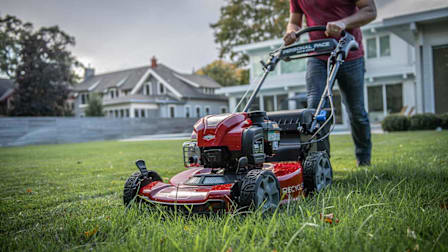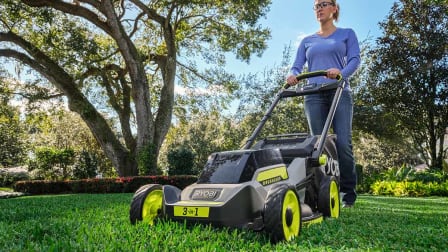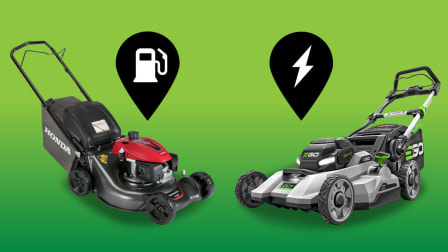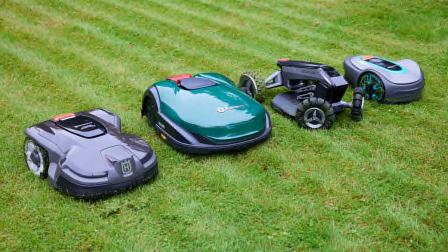How to Winterize Your Lawn Mower
Following these two critical steps protects your walk-behind mower’s inner workings in the off-season
When you shop through retailer links on our site, we may earn affiliate commissions. 100% of the fees we collect are used to support our nonprofit mission. Learn more.

Winterizing your walk-behind lawn mower should take less than an hour, and this relatively small effort will help ensure that it starts right up when you need it in the spring. The two simple steps could save you from the additional time and cost spent on a repair.
You’ll have to clean the deck and stabilize the fuel—or remove the battery, depending on the mower type.
Below, the lawn and garden experts at Consumer Reports walk you through winterizing both gas- and battery-powered walk-behind mowers. We also hit on additional maintenance that will have your mower humming along at its best when you roll it out for that first mow of the year.
How to Winterize Your Lawn Mower
Cleaning the underside of your lawn mower is a great idea for both battery and gas-powered models, while preparing your mower for storage will vary depending on the type of model you have. Read on for more instructions on cleaning and removing fuel or batteries from walk-behind lawn mowers.
Clean the Deck of Your Mower
Ideally, you should be in the habit of doing this throughout the season, because keeping the blade housing clean helps ensure optimal mower performance. But the task is especially essential before winter to help prevent moisture in stuck-on grass clippings from causing problems.
Store the mower in a dry location. Try putting a container of mothballs near the deck to prevent mice and other rodents from nesting in the dormant machine. (Mice are notorious for chewing through spark plug wires, fuel hoses, and even pull cords.) Better still, make your garage or storage area inhospitable to rodents in the first place, Trezza advises.
“Keep spaces tidy, minimize clutter, ensure that any food is tightly sealed away and inaccessible, and make sure leaves and other organic debris don’t build up around the walls of the structure,” he says. This buildup, he explains, can become a transition point, a covered area where varmints can stay close to walls and either find or create a way in.
Gas-Powered Mower: Remove or Stabilize the Fuel
Simply leaving fuel in the tank all winter can wreak havoc on your mower’s engine. Water from condensation can combine with ethanol in the gas, causing clogs, corrosion, and other problems throughout the fuel system. Come springtime, you could be in for a professional carburetor cleaning to the tune of $75 to $100.
- Remove the fuel if you keep your mower in the basement during the winter. Storing it inside could be a fire hazard. If there’s only a little fuel left after the last use of the season, your best bet is to run the tank dry. If the tank is full or nearly full, disconnect the fuel line at the carburetor and drain the remaining gas into a gasoline storage container. (You can add the leftover fuel to your car.)
- Stabilize the fuel if you store the mower in a garage or a shed. You can do so by filling the tank with gas and adding stabilizer—or even better, using prepackaged gas that has stabilizer already added. For good measure, run the mower for a few minutes so that the stabilized fuel can work its way through the carburetor.
Electric Mower: Remove the Battery
Remove the battery or batteries and store inside your home to minimize temperature fluctuation. Extreme temperatures can shorten the life span of battery cells and cause them to fail prematurely. Most batteries do best when stored between 40° F and 80° F. (Check the owner’s manual for the appropriate range for your mower.)
Other Lawn Mower Maintenance Tips
The above steps should keep your mower safe over the winter. But there are a few additional steps you can take now so that you don’t have to worry about them come spring.
- Sharpen your mower blade. Check out our instructions on how to replace a lawn mower blade. A dull blade might damage your grass with its ragged cuts.
- Consider an oil change. Not all mowers require oil changes, but if your owner’s manual recommends them, follow through on that advice. Routine oil changes will help extend the life of any engine, as will changing or cleaning the air filter. Spark plugs used to be more of a concern, but their improved technology has reached the point where you need to change them only every few years.
If you’re worried your mower might not make it through another season, look for end-of-season deals at home centers. Use our lawn mower ratings to find models that perform well and to check our exclusive survey data on the most and least reliable brands.
Best Walk-Behind Mowers
At CR, we test lawn mowers in specially prepared grounds in Florida, where we cut over 500,000 square feet of grass each year. Here are some of the best walk-behind mocels. For a more comprehensive list, see our picks of the best and worst walk-behind mowers.
































